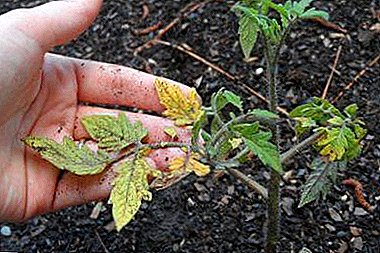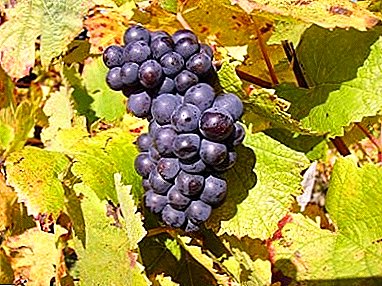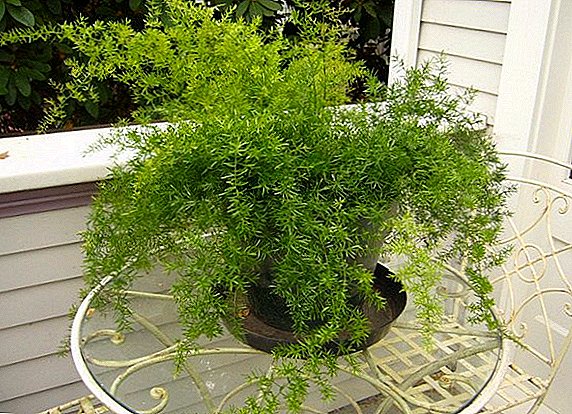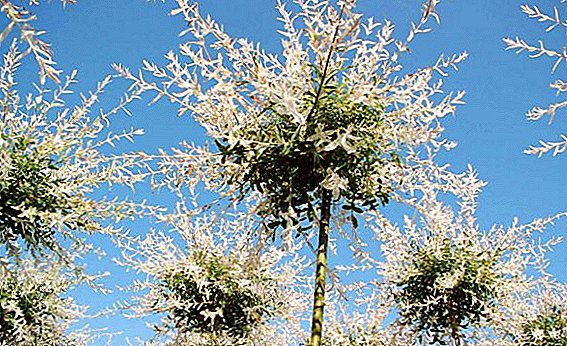 Willow "Hakuro Nishiki" pleases our eyes, announcing the imminent arrival of warm spring days.
Willow "Hakuro Nishiki" pleases our eyes, announcing the imminent arrival of warm spring days.
In garden design it is used quite often, because the bush is unpretentious and has a beautiful appearance.
Botanical description
Description of the willow "Hakuro Nishiki" will help to better know what kind of shrub is in question. This variety boasts a variegated foliage and accelerated crown growth. The shoots are green or purple, quite flexible.
Did you know? Willow is the fastest growing tree in the world. So, it is able to grow every year by 3 meters in height.Releasing in spring, the leaves show their beautiful light green color, and a little later bright pink spots appear at the top of the shoots. In the summer, the leaves become more pale due to the heat. From the flowering shrub of willow comes a very pleasant smell. The maximum size of willow is three meters in height and three meters in width, but usually these parameters are less than two times.

Growing conditions
In order for you to grow the most beautiful and large shrub, you should follow some rules of its cultivation. This refers to the landing site, lighting, as well as the necessary soil.
If you are going to decorate your plot with viburnum, magnolia, lilac, spirea, chubushnik, hydrangea, clematis, hibiscus, action, cotoneaster, barberry, heather, it is important to know what conditions they need.
Location and lighting
Place for landing on a mandatory basis should be isolated from various drafts. Whole leaf willow "Hakuro Nishiki" grows remarkably on well-lit areas or in partial shade. If the plant receives less light, its beautiful coloring will become faded and inconspicuous.
Optimum soil
The best soil for this plant is loose soil with a high percentage of moisture. That is why this variety prefers to grow near rivers and reservoirs.
Important! If you plant this variety in heavy soil, it will grow slowly and not get all the necessary trace elements.

Planting seedlings "Hakuro Nishiki"
It is important to plant a shrub correctly, because its further growth and beauty depend on it. So, you need to know at what time it is better to plant a bush and what planting rules exist.
Timing
The best months for planting willow "Hakuro Nishiki" - this is april or may. It is during these spring months that the shrub grows best in the soil, which has a positive effect on its further development.
rules
- Professionals advise to plant roots in water before planting. On average, this stage should take from three to six hours.
- To make the seedling take root better, it should be watered with plenty of water during the first 30 days after planting. It is also useful to mulch pristvolny circle - this ensures the maintenance of the required level of moisture near the bush.
- Choosing the interval between plants, it is worth considering their subsequent growth in width. So, you need to leave about two meters between each bush.
- Resistance to cold in willow is at an average level, therefore, shtambovy saplings are recommended to prefer varietal saplings. Shelter for the winter is also a mandatory event.

Did you know? This shrub is widely used in traditional medicine, as it is able to cure malaria and contains valuable quinine.
Scheme
First you need to prepare a large pit for planting (dimensions 70 × 70 cm). It should be put a little organic fertilizer, such as compost and humus. When planting shrubs should be done in the landing hole reliable drainage using sand or gravel. The thickness should be about 25 cm, and peat, sand, sheet earth should be poured into the pit and the mass should be mixed with the turf soil. Next, you should put a seedling in a hole and fill it with a mass of peat, sod land, sand or leaf soil. The landing site must be tamped down with feet or any hard object.
How to care for a grade
Willow "Hakuro Nishiki" needs not only proper planting, but also proper care. So, you should learn more about watering, feeding and pruning shrubs.
Watering
Willow - quite moisture-loving plant, which means that it requires quite frequent watering. Particular attention should be paid to watering in a drought, because the lack of moisture immediately appears on the shrub: the leaves fade and begin to fall from the willow. The overall decorativeness of the shrub is reduced even with a short-term drought. 
Important! For a plant more suitable too wet ground - it does not hurt him.
Top dressing
This variety grows remarkably well on poor and infertile soils, however, the true beauty of the shrub is manifested if the willow grows in high-quality soil. Complex mineral and organic fertilizers are used for fertilizing, which are applied to the area of the trunk circle. This should be done simultaneously with digging the area. For one top dressing you should take about 9 liters of organic matter per 40 g of mineral fertilizers.
Such activities should be carried out once in the fall and once in the spring. Gardeners also speak well of granular fertilizers for willow "Hakuro Nishiki." In the summer, it is useful to feed the leaf mass of the shrub. In this case, you need to make fertilizer with the help of a special "adhesive", so that all the beneficial substances remain on the leaves.
Pruning
Willow "Hakuro Nishiki" also needs timely pruning. This stage helps the correct formation of the crown of the plant. Pruning is recommended in early spring, before the juices begin their active movement. Do not be afraid to cut the willow too much, because it will only benefit it.
This shrub with incredible speed restores its new shoots, and the crown in the form of a ball, after the shoots grow, resembles large dandelions. In the first year should be cut no more than five buds. This is necessary so that the shape of the ball is closed. Subsequently, it is necessary to maintain a spherical shape, cutting with each year by 1-2 buds more. In summer, it is also necessary to trim the willow "Hakuro Nishiki" on the trunk for decorative purposes in order to maintain the desired shape. In autumn or spring, another pruning should be carried out in order to remove dry and damaged shoots.
Wintering plants
The tree is quite winter-hardy, but if the winter is cold and snowless, there is a risk of freezing. Standard willow forms are more susceptible to freezing during the cold period. For the winter, be sure to tie up and wrap agrofiber a tree grafting site.
In order not to freeze the shrub, in winter it is necessary to completely cover it with non-woven materials (polyethylene will not work).
How to breed willow
Reproduction of willow "Hakuro Nishiki" is possible by two methods: grafting or by grafting on the shtambe. The first option is the easiest method of breeding shrubs. If you decide to propagate by grafting, then it should be done on the goat willow shtamb. The finished plant must be formed into one trunk and cut off the branches of the crown, achieving the desired shape.
Pest and disease protection
Of course, the bush is not afraid of many illnesses, however it is necessary to carry out some preventive measures. So, in order not to develop various fungal diseases, the plant should be treated twice with any systemic fungicide ("Switch", "Ridomil Gold", "Skor", "Quadris" and others). This should be done around the month of March.
The most common pest are the grubs of the May beetle, which harm the roots of the plant. Only one larva can destroy about 30 cm of roots in one day. Young seedlings are more likely to be attacked by unwanted guests. For prophylaxis, it is necessary to treat the crown, the roots and the trunk with such preparations as "Antichrush" and "Prestige" (Bayer).
Important! The interval between procedures should be about two months.Willow diseases are practically not affected, however, in rare cases, diseases such as powdery mildew or branch necrosis may appear.
Willow "Hakuro Nishiki" - a wonderful ornamental plant, which is unpretentious in the care. It is only necessary to pay special attention to watering, and willow will delight you for many years with its incredible beauty.












